
Soon after Aron and I were engaged to be married, we started planning the honeymoon. We had almost 18 months until the wedding, so we took our time choosing a location and researching activities. One might say we had too much time, as we proceeded to compose spreadsheets comparing weather, costs, water temperature, food options, and so on for places all over the world. But it all amounted to a wonderful trip, one that we’ll never forget. And isn’t planning part of the fun?
PLANNING STAGE
We felt that we had a pretty optimal situation: we had a budget of about $250/day excluding airfare, just over two weeks in which to travel, and we had international miles tickets with Star Alliance at our disposal. Better yet, Aron’s parents had offered to upgrade our tickets to business class. So we knew that this was a good time to take a trip requiring a long flight. We could afford to lose a day to travel and we could do it comfortably. We had pretty much ruled out Hawaii and Mexico already, as both of us had been multiple times with family, but these factors allowed us to confirm that decision.
So we headed to our adopted library at the Grove in Los Angeles (Barnes & Noble), and began pouring over The Travel Book: A Journey Through Every Country in the World. And a long list of inspired places emerged. But it had to be affordable—we wanted to stay at nice hotels and feel like all the activities possible were available to us—so we took Western Europe, French Polynesia, and any European holds in the Caribbean off our list. We wanted at least part of the vacation to be at the beach and hoped for warm water; May is still a little cold in the waters off of Croatia and Greece, so those spots would have to wait for another time as well. We also worried we could get bored with “just” a beach vacation, so we looked for places that would offer other sights—interesting culture, cityscapes—as well. We began to narrow in on Costa Rica, India, Bali, Fiji, and Thailand. Any one of these would be wonderful and I hope we’ll get a chance to visit each soon. Bali came highly recommended, but we (probably unnecessarily) let the American travel advisory keep us away this time. Costa Rica and Fiji both had high averages of precipitation in May—it seemed a little risky. So Thailand or India? Both have cuisines we love, and both would satisfy all of our other requirements. As for India, we have a few friends whose family lives there, and we’d always thought it would be nice to travel there with them sometime. Actually, I think both of us were really excited about Thailand from the start, and so, even though the inches of rain could potentially be high there too in May, we happily began to make the arrangements!
Our itinerary would include Bangkok, Chiang Mai and one beach destination. We decided on Ko Samui—an island in the Gulf of Thailand (East). Phuket, an island famous both for its beauty and its plight when the Tsunami damaged its shores (now fully restored), is in the Andaman sea. Ko Samui experiences better weather and calmer waters this time of year, while Phuket’s monsoon season lasts roughly March to October. We really worried for a while about rain, but heard that while showers were often downpours, they rarely lasted more than an hour. We figured we could always head inside for a cooking class or relaxation if there was rain. As it turned out, we only had rain one night after dinner, and one day in Bangkok while we were inside having a massage. We experienced wonderful weather! (I did hear that while we were in the North, it rained every day in the South—so we were lucky.)
Aron and I were both in school at this time, so we each went to our respective University clinics to meet with a travel doctor. It was up to us whether we wanted to take any anti-malarial pills. We would be traveling near the Golden Triangle (a risk-area) but not in any actual malarial risk-zones. And we wouldn’t be staying in rural areas. So we decided against it. We were advised to each finish out our Hepatitis series (we already had done this), and get a typhoid vaccine—mine recommended a series of pills and Aron’s doctor recommended an injection. Both doctors recommended we bring along rehydration salts and anti-biotics in case of any food poisoning, as well as bug repellent containing Deet. In fact, they specifically recommended a spray for our clothing, to be used before packing, and a time-release bug repellent. Aron, an eager doctor-to-be, added his seal of approval to these advisories and added some general first-aid supplies to our shopping list.
We had already purchased a Frommer’s, Fodor’s, TimeOut Bangkok, Wallpaper Bangkok and a map by Nancy Chandler (which we didn’t use); printed pages from Epicurious.com, read archived Travel & Leisure articles and torn out articles from back-issues of Gourmet… I don’t want to think about how crazy all that must sound… so we began checking web-prices for our favorite hotel-picks. I found packagers like direct rooms, asia rooms and asia hotels to have the best prices, but it varied depending on the hotel. I also relied heavily on reviews posted on Trip Advisor (particularly the candid traveler photos) and the Frommer’s message boards for tips–adding to the insanity. I’ve listed our final itinerary below.
LOS ANGELES to BANGKOK (THAI AIR #795)
MAY 14, 10:30PM / ARRIVING MAY 16, 5:40AMHOTELS:
W, May 16-Sa, May 19 Bangkok: Marriott Resort & Spa
Su, May 20-M, May 21 Chiang Mai: Rachamankha
[Fly Bangkok to Chiang Mai (depart from Suvarnabhumi Airport), Air Asia 10:00am-11:10am] T, May 22-Su, May 27 Ko Samui: Tongsai Bay[Fly Chiang Mai to Ko Samui, Bangkok Air 10:35am-1:10pm] M, May 28 Bangkok:The Metropolitan
[Fly Ko Samui to Bangkok, Bangkok Air, 11:15am-12:20pm]
Returning Flights:
BANGKOK to SINGAPORE
May 29 SINGAPORE AIR#63, 11:15AM
Arrives SINGAPORE, 2:40PM
SINGAPORE to LOS ANGELES
SINGAPORE AIR #38, 4:05PM
Arrives LOS ANGELES, 5:25PM
BANGKOK
We arrived in Bangkok early in the morning (around 6am), but it was already noticeably hot and humid when we stepped outside of the airport. Our flight was into the new airport (Suvarnabhumi Airport–BKK) and we followed the clear signage toward the taxi stand after taking some cash (Baht) from the ATM. Our driver had been given the name and address of our hotel, but he seemed a little unclear as to exactly how to get there. As we were no help, he stopped at one point to call someone—they must not have been helpful either, because next he flagged down a a tuk tuk driver carrying some school children for additional advice. We found the whole thing pretty amusing, though we wished we could offer something other than pointing to a general location on a map drawn up in English. Not too much more time passed before we made it to the Marriott Resort.
There are two Marriotts in Bangkok: the JW and the Resort & Spa. The JW is perhaps geared more for the business traveler and is, as such, a bit more sleek, more contemporary. It’s located in the Sukhumvit area. On the other hand, the resort is located on the Chao Praya river in the Thonburi area and offers a bit more of an escape from the city and its sounds at the end of each day. In fact, one must take their water taxi, done in the traditional teak junk-boat style, to cross the river. The trip is short and takes one directly to a skytrain station; on the way back to the hotel, bottles of water and cool towels soaked in lemongrass are passed around. We liked the idea of being on the river, at a property with a large pool and a resort-vibe, so we chose the second location. And though I haven’t been to the JW, I can’t imagine being more pleased.
One of the highlights of staying at any Marriott property is that we get to use the Bruhns’ platinum member number—in other words, we get treated like better customers than we have actually been. At the resort, a special club lounge has been set up for such customers: breakfast (with juices, fruits, Western as well as Asian standards) is served there in the morning, tea in the afternoon and drinks with hors d’oeuvres in the evening. One can visit the main restaurant as well for a complementary (and even more extensive) buffet breakfast, but the other events only occur in the lounge. Also, when we arrived, we we taken over to the lounge for breakfast while a concierge who had been assigned to us completed our registration. While crossing the lobby, I noticed that the whole area smelled of lemongrass. Fortunately, some rooms had become available early, and we were able to go upstairs before too long. Our room was wonderful—large, with a balcony overlooking the river, it had a particularly sizeable bathroom, as well as distinct sleeping and sitting areas. A fresh fruit basket included lychees, mangoes and oranges, and was refilled daily. There was also a large selection of newspapers and a notice offering complimentary laundry and pressing services. It was going to be hard to leave. However, we left for the day pretty immediately. Tempting as it was to lay down or go for a swim, we were too excited to see the city. We thought it would be a good day to visit the palace as well as one of the temples, so we were careful to wear our long pants and chose a shirt that covered my shoulders. Passing by the beautiful pool area, we walked out onto the hotel’s dock and caught the next boat crossing the river.
The boat let us off at the Silom sky train station, where we could also catch a water taxi heading up—as we would do to get to Wat Po—and down the river. We did encounter here, however, our first and only unpleasant solicitation experience. A man in plain clothes began a conversation with us: said he recognized us from the hotel… did we check in this morning?… He works there along with much of his family… He hopes we have a nice visit… Oh, where are we headed today?… Wat Po? It and the Palace are closed for a special holiday… etc. We said we were going anyway, doubtful that he was correct, and when we arrived at Wat Po our suspicion was confirmed. We noticed the same man there on subsequent days. It was unpleasant because we had engaged in the conversation with him and yet he lied. That said, it was our only such experience. I’ve heard plenty of accounts of this happening to others, too, but while it seems a good idea to be aware and not to let someone talk you out of your plans or into a store you didn’t want to visit, I wouldn’t let this prevent you from being open and friendly to the people you encounter.
Wat Po is also known as the Temple of the Reclining Buddha, as it houses a 46 meter long, entirely gold, reclining Buddha. Made for Rama III in 1788, the soles of his feet are decorated with mother of pearl and display 108 scenes of the Buddha. One of the oldest and largest temples (80,000 square meters), its southern compound is devoted to a working monastery and its northern houses the Buddha and a massage school. It’s filled with brilliantly colored porcelain chedis, one for each of the first four kings of the Chakri dynasty. I also particularly enjoyed the large statues standing guard at the temple’s gates. Many of the buildings are laden with gold leaf and beautiful plaques, however much of the area was obscured by scaffolding as restoration was ongoing.

The palace also has a notable Wat (Wat Phra Kaeo) housing the Emerald Buddha. Preparing to see it, we removed our shoes and took care to keep our head lower than the Buddha, our backs and the soles of our feet pointed away. The first requirement is a challenge for Aron who, at 6’8”, towers above most of the resident population. As amazing as the Emerald Buddha was, it seemed surprisingly minuscule after visiting the reclining Buddha.
The Chedi behind the Wat was especially beautiful, gold-leafed and done in a Sri Lanken style to house the breast-bone of Buddha. In fact, there were gold and brilliant shades of blues and greens and the entire spectrum, all over the place. The architecture was stunning, and I doubt I can do justice here to its detail or its history. One would benefit greatly from the assistance of a guide or a tour book when visiting.
Following a recommendation from our Frommer’s guidebook (“Find this place. It is my favorite place in Thailand.”), we found this very simple spot called May Kaidee perched in what seemed almost like an alley. But the food was as good as any Thai food I’ve tasted—better than anything I’d had at much more formal establishments. We shared a large beer and each had curry for under $5 total. The massaman curry was incredible!
Our lunch spot was in the Khoa San Road neighborhood, so we decided to stroll around. Sometimes called the backpacker’s ghetto, I recognized the main street immediately from a Leonardo DiCaprio movie named after and based on the novel, The Beach. Indeed, it had all the hallmarks of a hosteller’s zone: plentiful internet cafes and ATMs; cheap, international eats; Rastafarian icons and lots of young westerners. Still, while at once almost disturbingly familiar, the area held its own distinct charms and we enjoyed the lively street for an afternoon.
tourist destination. Sometimes, I feel guilty—shouldn’t I prefer to wander the Louvre to see the Egyptian collection over wandering the neighborhood of St. Germain to taste a macaroon, for example? But everyone has their own must-lists when traveling and mine is browsing the streets, window-shopping the bakeries and bookstores and whatever else might give me a glimpse into local peculiarities and predilections. So while it was tempting to see more of “old” Bangkok’s Wats or travel to Jim Thompson’s house, we opted instead to check out some of the more trendy shopping streets and discover new Bangkok. This time we took our main
cues from the Wallpaper guidebook and the Luxe Guide.
When we returned to the hotel, we relaxed for a while and enjoyed the lounge.
That evening we had reservations for Bed Supperclub, where one eats dinner from the comfort of a long, white bed in a large, UFO-like pod which sits raised above the street. A fax from the restaurant had been delivered our hotel-room (4 pages!) specifying a dress code, reminding us to bring our IDs (no minors allowed), and mentioning some other policies as well. It was pretty amusing, but we sort of enjoyed the thought that our coming to dinner was worthy of a personal fax delivery to our door. The restaurant is divided into a dance club and the main dining room. We started in the latter and moved into the former. The menu listed lots of interesting cocktails featuring many of the fruits we’d seen at market stalls earlier in the day. Dinner was delicious—I recall having lobster and rock shrimp prepared with a fusion of Thai and European flavors. A DJ spun during dinner and various characters performed in a non-obvious sort of way: a man all in white sort of moon walked through the room, a tarot card reader set up a table in the corner, a masseuse performed foot massages to those who wanted them. It was an interesting scene!

And it only got, um, better. We went into another large area within the market wherein most of the meat is sold. As you can probably imagine, there were some sights I would have preferred to hold off on until after we cooked lunch. One which surprised me a bit was the stand selling water beetles—it’s not often that you see such large beetles, even less often that you see them sold at a food market. Our guide held them up for us to smell their undersides—like sweet citrus. Apparently they’re most commonly used to flavor soups and stews.
Some of the smells in this particular room were a little overwhelming, so I was a little relieved when we began to make our way back out of the market. That said, the tour was a completely enriching and fascinating experience, and I felt like we learned so much more about what we were seeing with the help of a guide than we could have possibly discerned on our own.
We took the skytrain one stop back to the cooking school and got settled in one of the classrooms with a demonstration kitchen. A folder of recipes using many of the ingredients we had investigated at the market, along with an apron, was waiting at each desk for us. We would be learning to prepare chicken satay, a beef waterfall salad, fish stew, and a shrimp curry. The head chef would talk about one dish, show us how to prepare it in the demonstration classroom, and then we would go into the kitchen to make the dish ourselves. We each had a station with the ingredients laid out alongside the necessary knives; each station had a gas stovetop as well. For the satay, we mixed the peanut sauce and a marinating glaze, then skewered the chicken. Then, assistants who were ready to help at any point would taken the skewers and grill them for us while we went back into the classroom to begin learning about the next dish. It was a nice blend of demonstration and hands-on experience.
One thing that is difficult about going out for a massage rather than having one at your hotel is that you have to re-enter the street life and within hours you feel like you could use another massage. They’re sort of addictive, I learned. We decided to return to our hotel and do some more swimming before dinner in a small effort to prolong the feeling.
Dinner was at Spring and Summer, where Spring is a house built in the 1960s serving modern Thai cuisine, and Summer is a chocolate themed café. Both sit back from the road with a wide sprawling lawn between. One can book a set of pillows for the lawn (winter lawn/bar) and be served by waiters wearing what look like painter’s overalls.
The place was filled with young (and seemingly affluent) Thais wearing the sort of high fashion we saw at Playground!.
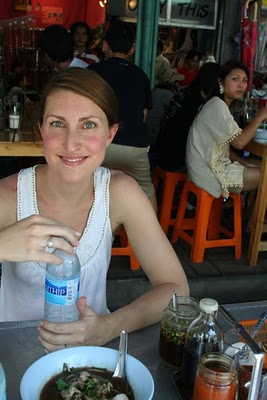
We were very interested in taking a river tour, but felt our time was too spare to take the four hour khlong tour advertised by some of the boat operators. Instead we paid extra to hire a boat and driver from the Thonburi area to take us down to the River City shopping complex. At first the driver was reluctant to take just two people when he could take 6, which is why we paid a little extra. The boat was a longtail—a VW bug engine is attached to a drive shaft, which is long and motors a propeller; the boat itself it long and narrow with small wooden slats spanning its width for seating. We sped down the Chao Praya, slowing down only when crossing the wake of a bigger boat or when passing an interesting site.
When our driver dropped us off at the river-city complex, we looked into finding a recommended tailor for Aron to have a custom shirt made. Unfortunately the spot mentioned in the article I had brought along was closed, but we decided to seek out another top pick near the Siam Centre (a huge shopping complex at one of the major sky train stops). It came to about US$50—we would pick it up when we returned to Bangkok on our way out of Thailand. Something really interesting happened while we were walking around this bustling area: the national anthem came on (it plays in public areas everyday at 8am and 6pm) and every person stopped and stood still to pay respect. We stood and joined—it was so remarkable to see such a busy sidewalk suddenly come to a complete standstill and just as suddenly come back to life with movement and chatter.
CHIANG MAI
We left our lovely Bangkok hotel in the morning, and headed to the airport. For our peace of mind, we had booked our flights within Thailand before we left the U.S., this time with Air Asia. In typical fashion, we got to the airport far too early, but this gave us a chance to sample ginger and lemongrass sodas–delicious when drunk together! The flight to Chiang Mai was smooth and I would certainly use Air Asia again.
Once we arrived in the small airport, situated among beautiful mountains shrouded in a light fog, we made our way to the taxi stand and bought a coupon for a taxi which would take us to our hotel, Rachamankha.
Like all the hotels we stayed in, we chose this one after great deliberation, and when we arrived at the hotel I could see that we would not be disappointedwith our choice. The hotel is modeled after the viharn (chapel) of Wat Phra That Lampang Luang in the neighboring province of Lampang and the staff clearly tries to maintain a certain sense of the serenity one would expect to find at a temple.
The staff was small, but extremely eager to help us without being intrusive. After refreshing with cool lemongrass towels and cold tea, we were shown to our room. Along the way, one couldn’t help but notice the beautiful lanna architecture, the lovely flowers and antique the Asian artifacts all around.
The room itself was a throw back to another time. Tall, heavy, teak doors that locked with a wooden latch opened to reveal sloping ceilings, a large canopy bed and heavy teak furniture. They had noted before we checked in that we were “honeymooners” and had a bottle of champagne on ice waiting inside. The bathroom was well-appointed with wonderful smelling hand creams and hair products. In fact, Aron, has continues to slowly ration out the hand cream, keeping it in our medicine cabinet, he enjoys the smell so much (and so do I). I wish I had brought home one of the robes, myself.
Exploring the hotel, we found they had a lovely library room with a computer and internet access as well as a complimentary bottle of Brandy and some snifters available for guests. Had my husband known this back when we were debating whether to stay at Tamarind Village or Rachamankha, I am sure there would have been little question as to which hotel we should choose! The pool was equally beautiful and serene, but a swim would have to wait until later.
Though most of the day had passed, we knew we had little time in Chiang Mai and decided to make the most of the remaining afternoon. As it was a clear day, we decided to visit Wat Phra That Doi Suthep, a temple about 45 minutes from the hotel and which can often be seen from they city as it sparkles with gold leaf. We had intended to take a taxi up to the site, but instead combined the trip with a hill tribe museum using the hotel’s car and driver. It was expensive compared to a taxi, but still cheap compared to U.S. prices.

After climbing some 306 steps, we were rewarded with an excellent view over the valley and a beautiful temple. Wat Phra That Doi Suthep was founded in the 14th century where a white elephant died while carrying a relic of Buddha. Compared to the other temples we had seen, this one seemed to have more Thai than tourists and it was interesting to see the ways that people practiced religion.


The next day, we headed to the hotel’s restaurant: situated around a beautiful courtyard we enjoyed multiple courses of breakfast before heading off for our planned activities. We had arranged to go to an 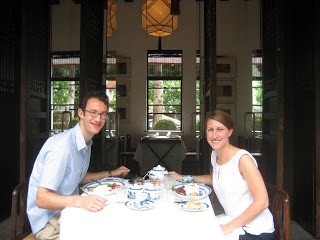
We arrived just as the elephants were taking their morning baths (and showers, as they would have it). It was amazing to see such powerful, large creatures being so playful and so obviously enjoying themselves.
Next, the elephants put on a show, where they and their mahout (trainer) demonstrated both the tasks elephants were traditionally employed to do in Thailand—such as moving logs—as well as newer skills such as painting and playing soccer. Though impressive, I was happier watching them play in the water than performing for us. That said, we still maneuvered ourselves for a quick exit (our driver came over and pointed us in the right direction) after the show was over so that we could be first in line for the elephant ride. We climbed up bamboo scaffolding to a plank where we had easy access to the basket strapped onto the elephant’s back and stepped inside. That was the easiest part of the whole operation.
As soon as this amazing and huge animal started walking, I knew we were in for a rough ride. His giant strides would cause our seat to sway significantly back and forth. We held on to the edges, turned to each other and started to laugh! During his descent down into the river, I was sure we were going to fall off. His movements pitched us to and fro, to and fro, to and fro… until he was fully into the river. Being with the very first elephant in line was excellent, as it allowed us to imagine that we were exploring the terrain alone, forging through the jungle on an elephant with our mahout. Looking behind us, however, and seeing all the elephants in a line, trudging through the river was pretty neat too. After our ride through the dense jungle, and then alongside crop fields, having twice crossed the river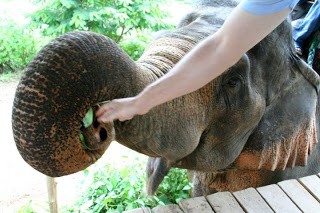
So before we disembarked, we bought some fruit at a stand conveniently positioned on stilts so it would be just at our height. I had intended to extend the ple asure of feeding him, but before I could untie the bundle, he had felt them out with his trunk and just as swiftly placed all 5 or 6 in his mouth at once. Incredible.
Our mahout had taken us on a generally circular path, but for the last section we switched to a Brahma driven cart (it seemed sort of funny, but it was all part of the package). The last leg of our trip was a bamboo raft ride down the river. We had some curry for lunch and made our way back down to the river. Before we got on the boat, our guides insisted that we wear the pointed straw Chinese hats they provided. We acquiesced and settled onto the bamboo, peacefully drifting down the river. Our “boat masters” polled us through the slow sections, offering us opportunities to do the same.

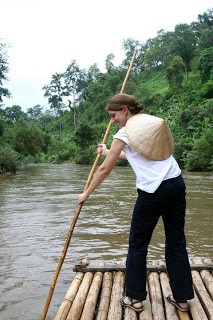
It was embarrassing, but our driver had actually let us borrow some money to purchase our entries; the camp only took cash and were a bit short. So after we stopped at an ATM, we thanked him heartily and said goodbye as he dropped us off in a shopping section of the city.
Chiang Mai is known for its wood crafts, especially its lacquer boxes, and Aron and I were excited to try to find some simple, sleekly designed ones like those they had at the hotel. To our dismay, all the boxes we found were designed for a different aesthetic and were heavily painted with flowers or animals. There were more stores further out and scattered around the city but we didn’t want to deal with arranging transportation and opted for an afternoon massage instead of shopping. We washed our feet, changed into the clothes they provided and split into our own rooms for an hour massage. After a wonderful hour, we were eager to get back to the hotel for a swim.
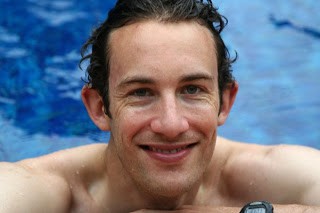
Back at the hotel, we enjoyed a delightful swim. The water felt wonderful and we relaxed by the pool for some time. Apparently, Angelina Jolie had stayed there a few weeks prior to our arrival, but we found the hotel to be very quiet and we almost had the place to ourselves. Aron enjoyed a quick brandy before we headed off to dinner.
For dinner, we had made a reservation at the restaurant at the Mandarin Oriental Dhara Dhevi, just outside of Chang Mai proper. This was one of the newest hotels, built following recent movements toward vast, self contained hotels like the Four Seasons Tented Camp, Golden Triangle, outside of Chiang Rai. Our dinner was at Le Grand Lanna, a restaurant designed to mimic the experience of dinner at a nobleman’s home. It was a lovely wooden house, near the entrance, whose dining area was elevated with a view down to a reflection pond. The food was excellent, with a focus on traditional preparation and regional cuisine, and the service had the perfect balance of being available when they were needed, but not hovering or interrupting the meal. Some excellent live music accompanying performers dancing traditional Thai dances added even more to the evening.
After dinner, we set off to explore the hotel. Extravagance is clearly the rule at this hotel and a golf cart took us the drive up to the hotel to and to an exalted lobby (from where we could ask the concierge to call us a cab). We explored the lobby and looked off to some of the rooms, but barely scratched the surface of the property. Built to replicate a Chiang, a self-contained city, the 60 acre site contains multiple restaurants, self-contained wats, a working rice-field, and many different styles of individual rooms and cottages. There is also a cooking school, spa, and cultural center. It certainly seems a very luxurious option.
In Bangkok, we always opted for either a taxi or the sky train over the tuk tuks—a motorcycle fitted with a carriage-like seating attachment. They are a distinctive sight and a fun way to travel, but they can be less so in Bangkok where one is likely to be stuck in traffic (and its fumes). But in the walls of old Chiang Mai, we figured we could enjoy a relatively comfortable tuk tuk ride. It was a lot of fun to zoom past the old moat–which was used to protect the city from 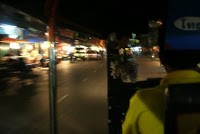
KOH SAMUI

We had chosen the Tongsai Bay Resort and Spa after much deliberation over whether to stay there or at Sala Samui, a slightly newer hotel with private pools for many of its rooms. Both are at the same end of the island, but TongsaiBay has a private beach, and we would have an ocean view and a large soaking tub to enjoy from our teak deck. The drive to our hotel took us past the busy main beach, Chaweng. Through the buildings we could see glimpses of the water and the sand, but the crowded and dusty main street made us think we had made the right choice to head for a more secluded location.
Arriving at the hotel, we were greeted, once again, with cool towels and cold herbed tea. The lobby was lovely, with large dropped lights in shades of pale oranges and reds. There was no a/c as the room was open to the outside, but there were many fans around which helped to make the high temperatures tolerable (it felt considerably hotter here, in the south, than in Chiang Mai or in Bangkok). Once checked in, we were driven to our room in a golf cart; another cart followed behind us carrying our luggage (yes, it was somewhat embarrassing). We climbed over some small staircases off the road to a private cottage. Opening the door to the room, were delighted to see rose petals on the bed and a bottle of champagne on ice. We were given a tour of the room and its features, but at times it was hard to pay full attention—I kept getting distracted by the view!
Stepping down from the main level, to the living room, we grabbed the ice bucket and the glasses and set ourselves up on the balcony. From our deck, you could see the entire bay and down to the beach where we would end up spending most of our time. On the deck and secluded from view, the deep soaking bathtub was equipped with great smelling bath salts, soap, shampoo and conditioner and was practically calling our name, but while there was still good light we wanted to explore the town’s main beach.
The hotel provided a free shuttle (otherwise one could take a taxi for about $10) a couple of times a day to Chaweng, and we just had time to catch the last one. The road was lined on either side with small stores selling tourist goods, as well as a few scattered bars and hotel entrances. We passed through one of the hotels and made our way out to the beach. Walking into the water felt heavenly; you could barely discern it, it was so warm. The beach was not too crowded, and had some nice looking bars for enjoying waterside cocktails. A few jet skis zipped far off shore and were available for rent. We strolled down the beach, checking out the hotels and noticing several that we had once read about.
We left the sand and returned to the road to check out where dive companies would be taking their clients, and inquired as to which tours were available to the nearby Ang Thong national marine park. In the end, we decided to go with Blue Stars for a trip to the marine park (primarily based on the boat speed to the park and the activities available once there), and Easy Divers ($43pp) for a 2-dive trip to Koh Tao. In between each activity, we would spend the days relaxing at our beach. By this point in the afternoon, we were thoroughly steamy, so we stopped for a cold drink before getting on the shuttle for the 20 min trip back to the hotel.
After getting so hot walking around town, it was wonderful to get back to the hotel and go for a refreshing dip. There were two pools available, an infinity pool where children were not allowed, and a free form pool with thatched umbrellas and a bridge crossing the pool (so one could sit in the water but not in the sun). Not wanting to miss out on anything, we explored both. This was both of our first encounter with an infinity pool and we loved looking out and seeing nothing but the ocean! The free form pool was also delightful, and we appreciated the option to stay in the shade. Ever since Aron did a dermatology rotation, he’s been a much bigger advocate of sun protection (rightly so) and we’ve both tried to consistently apply high SPF sunscreen and sit in the shade. We selected two lounges under a thatched palapa. Soon after we sat down, someone came over with towels and set up a small table between us with cold water and glasses. Despite our best efforts to stay protected, however, we were amazed (and a bit dismayed) when we found later that the reflection off of the sand had still burned the sides of our legs!
For dinner, the hotel had three options. We were going to dine beach side, but the main restaurant (up on the hill near the lobby) was offering a traditional Thai tasting menu accompanied by a live performance of traditional Thai music and dance. Though the hotel 
The next day we were picked up in a van to be taken to the docks for Blue Star tours. The Van ride was a harrowing trip, and though Aron has had similar experiences in other countries (lots of blind passing, bumpy roads, etc), even he noted that this was one of the most stressful car rides he’d had. We arrived at the boat and settled in for the 1.5 hour boat trip to the marine park. The boat offered some delicious fruit and some bad coffee, and having had to arisen earlier than other days, and having missed our hotel’s breakfast, we took advantage of both.
Once at the park, the company divided the participants into two groups, those who spoke 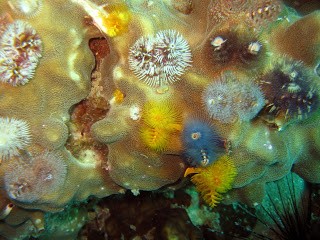
Next it was our turn to use the kayaks. Aron and I shared a kayak and followed the guide out to some of the islands. We found it best to be either in the very front, or the very back of the group, as it seemed most people preferred to clump in around the middle, which of course led to a few crashes and less idyllic views.
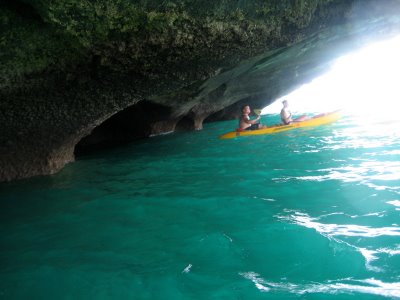
After an excellent tour, we pulled up onto a nearby beach in order to see where an interior saltwater lake had formed. It was a steep climb, mainly up but also down stairs that functioned to separate those who were in shape and those who were not. Unfortunately, swimming in the emerald waters is prohibited, but it was beautiful and we found it interesting to note the sea cucumbers and anemones visible on the lake’s edge, despite the lake having no obvious connections to the sea. Climbing back out of the lake, we made another brief climb to the ridge’s peak for an excellent view of the lake and the surrounding islands.


Back on the beach, Aron had a cold beer before we paddled to the next site. And after some paddling, the best thing was jumping out of the kayak and cooling off in the temperate waters. Before we left, we had some fun jumping off the upper deck of the boat.

We staked out our favorite spot under a palm tree at the beach. It was a lovely day, mainly spent reading books and magazines, punctuated by refreshing swims. The hotel has kayaks and a small sail boat on hand for guests and Aron went out with a staff person for a sailing lesson (all equipment and lessons were free of charge, or included in the cost I suppose is more accurate), while I grabbed a kayak and followed for a bit. Once they were clear of the cove, I headed back in and followed the shore of our hotel’s bay. I was able look up from the water and see the edge of our room’s deck.
For lunch, we stayed beach side at Floyd’s bistro and discovered what was to become the lunch for the rest of the trip: the chicken satay sandwich on multigrain raisin bread. It was amazing. Fortunately, Aron continued to try different menu items that looked interesting, and I would branch out vicariously; however, he inevitably try to steal half of my sandwich, always preferring it to the other things he tried.
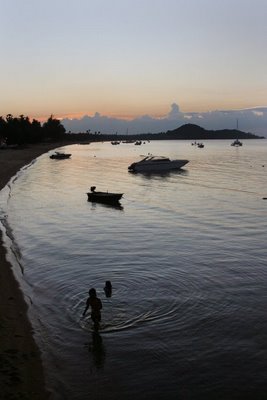
That night, we decided to venture out of the hotel to the Fisherman’s Village, a smaller town than Chaweng, known for good seafood served fresh from the fisherman’s boats. We ended up choosing one of the several restaurants overlooking the water. Most had similar menus and looked equally nice. A common theme amongst these restaurants is for you to choose a whole fish from a table of ice, after which they prepare it for you as you like. Aron chose to do this, while I had the shrimp Curry. Both were very good, though I kept expecting the curries to be spicier—they were clearly tamed for Western palettes almost everywhere we went. All the restaurants here were open air and, without a fan, even a few iced cocktails couldn’t quite cool us off, so we were glad to return to our A/C-ed room. I should mention that we smothered ourselves in bug repellent throughout the day, and this contributes to some discomfort with the stickiness of the heat.
Alternating adventure days with our beach days, we were set to go to Koh Tao, Turtle Island, for some diving the next morning. We had booked with Easy Divers, and were picked up in a private car that drove safely yet efficiently to a small collection of huts.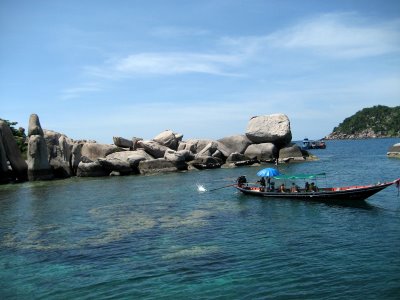


Once in the warm, clear water, it was only a few moments before we were descending to the coral. Most of the reef lies fairly shallow, somewhere between 30 and 60 feet, which makes for better colors on the reef (the red light is absorbed as it passes through the water) and for a longer dive. It seemed as though thousands of fishes were swimming in and out of the coral as we approached. Christmas tree worms were plentiful and were fun to scare back into their holes. There were also many large anemone and clown fish—great to interact with. It was an excellent dive! We surfaced and made our way back to the docks for a Thai buffet. The food was good and plentiful, the restrooms facilities basic but workable. While our food digested and the nitrogen left our bodies, we walked out to the cove on the other side of the island and admired the light turquoise waters which had no greater depth than 5 feet for the entire circumference of the cove. After our walk, we got back onto the boat and headed minutes off the coast for the second dive.
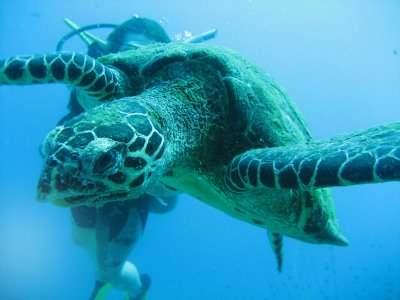
We were enjoying the fish and the reef when I turned to see a turtle coming to investigate us. He left almost as soon as we saw him and I figured we had scared him off. We went back to enjoying the reef, but a few minutes later he was back again. We swam to keep up with him and were amazed at how comfortable he seemed to be with us. Hovering next to him, we watched as he snacked off the reef, a bite here and a bite there.
The ride back was easy; we slept and reviewed the photos we had taken, and then were dropped off directly at our hotel. Our dive master was excellent and we would definitely recommend this company for divers in Koh Samui.

Stopping at the concierge, we enquired about reservations for dinner at a place called Poppies which our guidebooks said had good food and which was described as romantic. We hopped into a golf cart for a ride back to the room (by this point we had learned how useful this was to keep from over-heating, and the staff never made us uncomfortable when we took advantage of the service), where we could freshen up, and relax in the tub before heading out again for the evening. The price of a taxi from the hotel to various destinations was fixed, which reduced the stress of bargaining, though it may have ended up costing us a dollar or two more. When we got to Poppies, we were greeted by the hostess and soon “Tongsai Bay Room 12” was seated by the beach. Torches and a beach-side location definitely added to the aesthetics of the location, but the live music, a terrible jazz cover singer, and bright electric lights definitely took something away from the romantic potential of the meal. The food was good, but pretty standard, and though it was perhaps a dollar or two cheaper than the food at our hotel, it was a wash after the cab ride. Though there were many more restaurants to try on Koh Samui, we decided that we preferred to stay at the resort and leave the food exploration for more exciting places like Bangkok.
Our last full day in Koh Samui was spent primarily on the beach. Inspired by our previous kayaking, we took a double out for a little exploration. Going left around the edge of our cove, we found a small and completely unoccupied beach. We paddled our boat to shore and enjoyed the peacefulness of the area. The hotel did not allow any motorized water crafts, so there was nothing but the sounds of the water and the breeze to fill our senses. After paddling back to the hotel’s beach, we took up station again at our favorite spot and did some more reading and napping.


In the afternoon, we managed to move the 100 feet from our beach chairs to the beach bar. There, the hotel provided complementary drinks for a guest social hour. Though we had been devout attendants of this throughout our stay, this evening’s drinks were especially delicious: they had filled a large bowl full of fresh coconut juice and coconut meat, which they then served on the rocks and spiked with rum for those who desired it. Aron stuck with the gin and tonics or Thai whiskies with coke, I though the coconut juice was perfect! I am not sure how much we socialized during those hours, but we sure had fun!
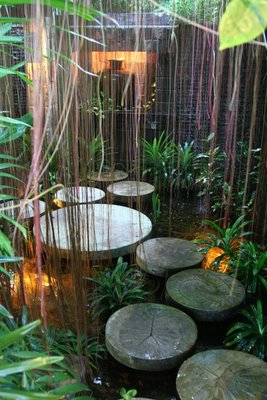
The next day, with great reluctance, we packed our bags and made our way back to the airport for our return flight to Bangkok.
BANGKOK
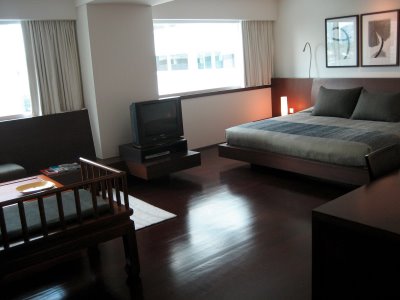
Having had such an amazing experience at Roti Mataba, we set out to try another recommended street food spot. This one was directly across from a Wat known for its cartoonish decorations. Unfortunately, the food here, while very good, was not quite as amazing. On the other hand, they had big, cheap beer to help cool us both down and it was nice to return to the drink prices of Bangkok after a few days of resort up marking. (And we needed the beer—it was hot! We couldn’t help but laugh as Aron’s shirt, whether from the heat of the day or the heat of the curry became more and more visibly wet while the locals seemed cool as cucumbers.)
We had so little time and so many interesting things left to see in Bangkok. We decided, however before we had even arrived that we would return to Ruen Nuad, our favorite massage location. Fortunately it was just a short walk across the Silom Avenue from our hotel. Given the great prices and wonderful experience we had before, we decided to do a one hour foot massage followed by a one hour traditional massage. We changed into their spa wear and sat back to 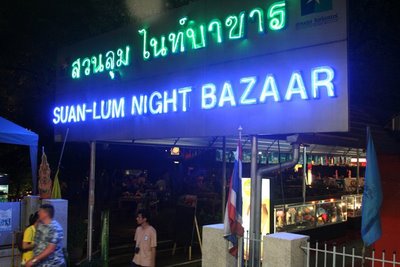
We headed back to our room to enjoy that post-massage bliss before heading back out for the 
Our last stop before heading back to the hotel for our last night was to the sky bar, Vertigo, at 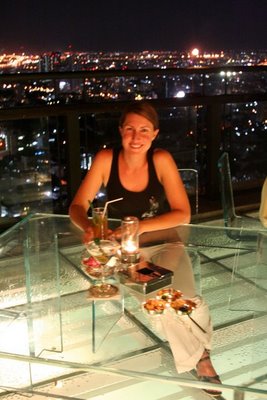
The next day, before we left, we did had time to enjoy perhaps the best breakfast we’d had throughout the whole trip—and that would be saying a lot, because we had some amazing ones. The room’s price included a breakfast at Cy’an, the hotel’s restaurant. Lovely fruit bowls, granola and yogurt were set out amongst fresh cut prosciutto and various pastries, available for those who wished. But one was also invited to order off the 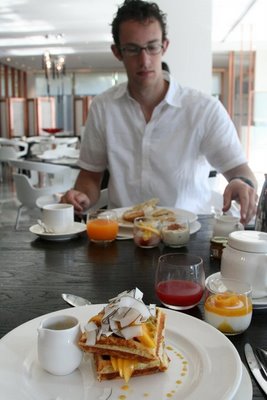
Leaving the hotel was a sad affair, as it meant the end of the trip. We took care to spend all of our baht excepting the cab fare, and made our way to the airport. Our only conciliation was that we would be flying business class on Singapore Air. We settled into the seats and kicked back to enjoy the amenities, drink some champagne, and reflect on the amazing trip as well as look forward to the wonderful life and union that lay in store.
There may have been some hesitation to choose to go to Thailand over more traditional honeymoon destinations, but after experiencing this amazing country, it is hard to imagine having gone anywhere else.



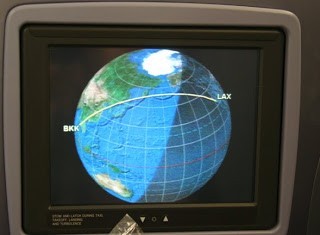
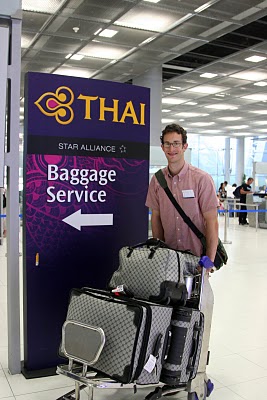
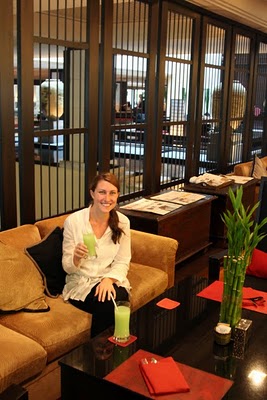
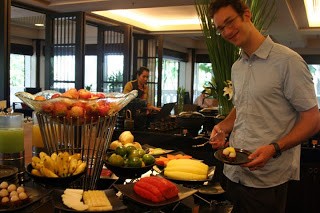
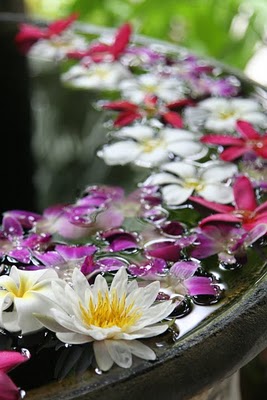
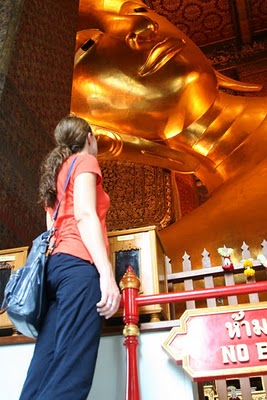
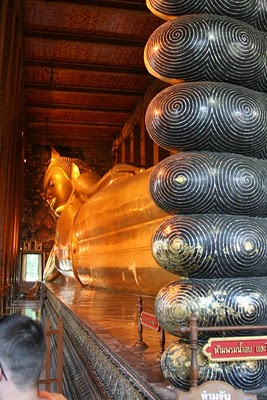
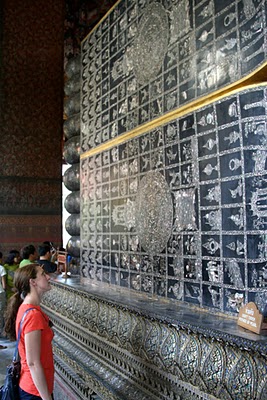
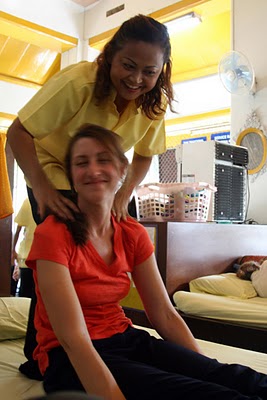
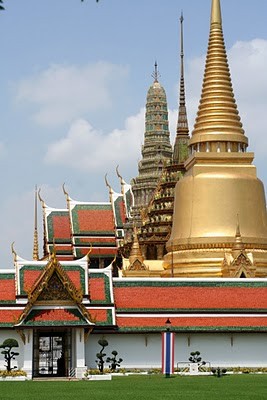
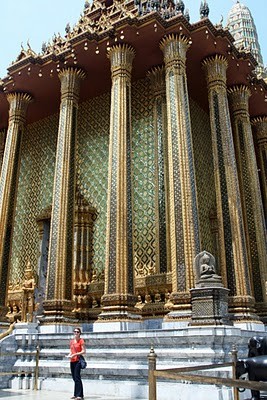
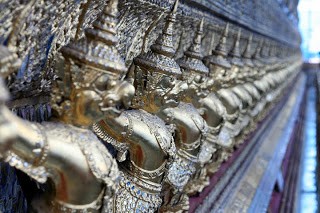
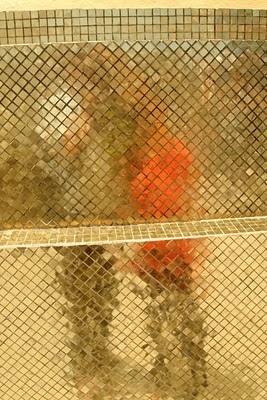
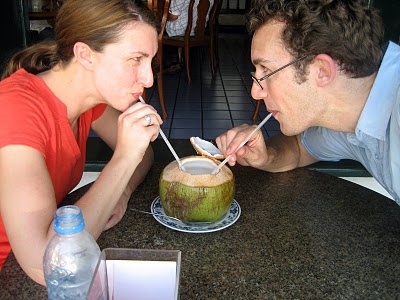
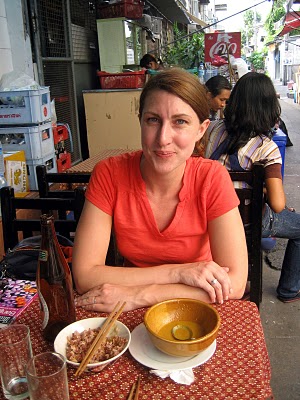
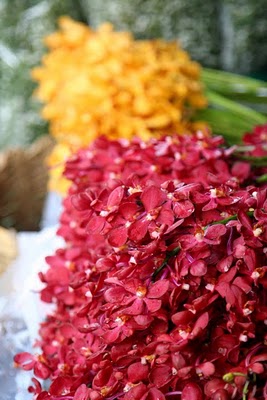

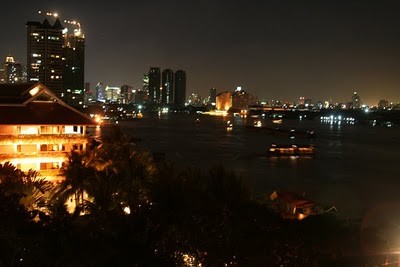
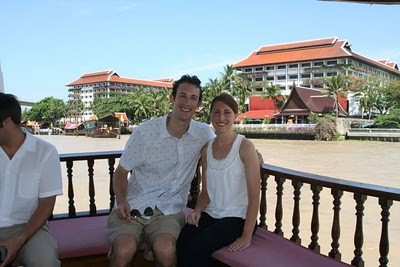
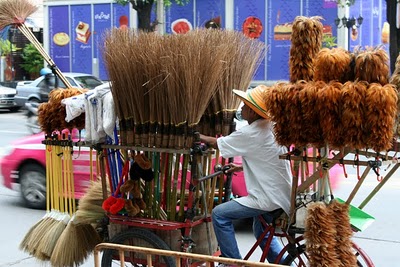
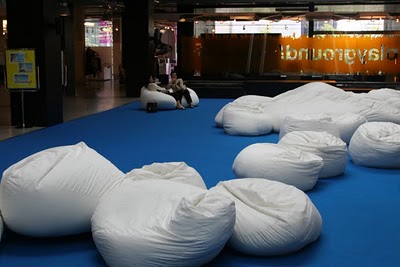
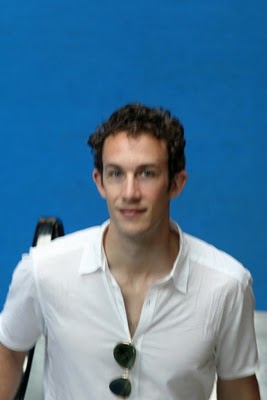

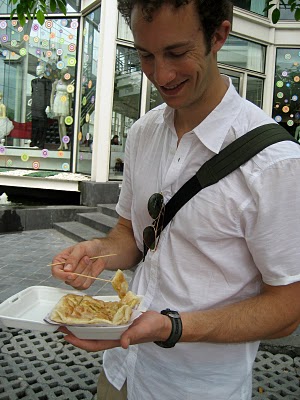
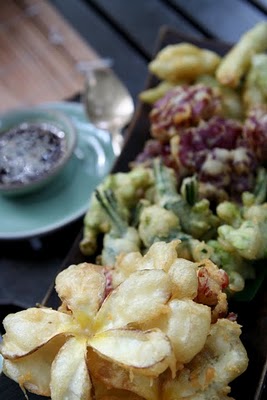
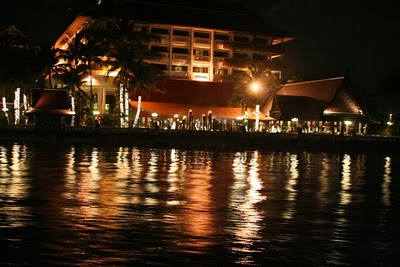


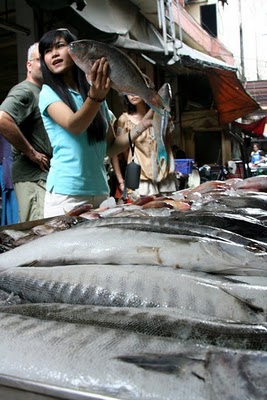

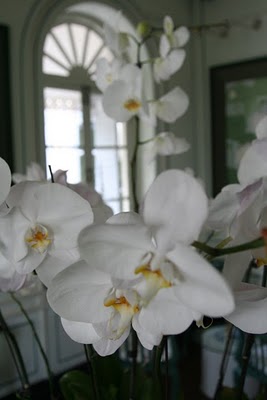
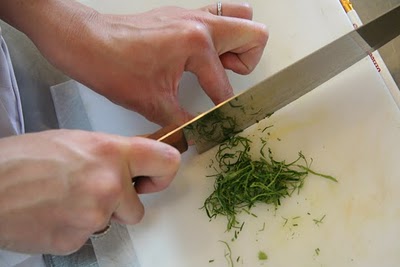
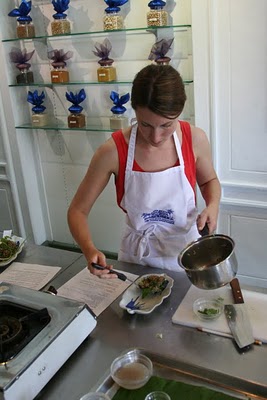

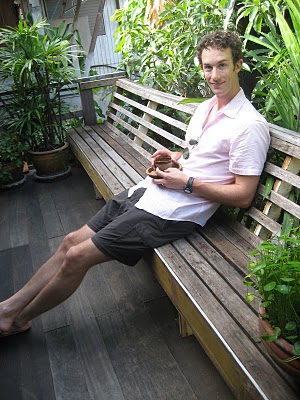
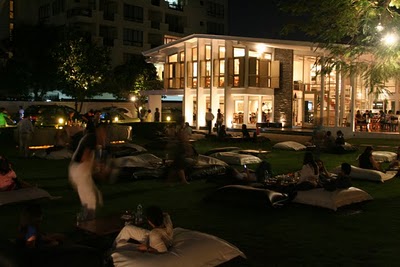
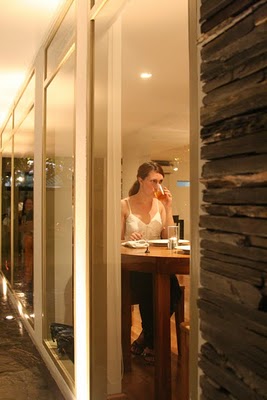
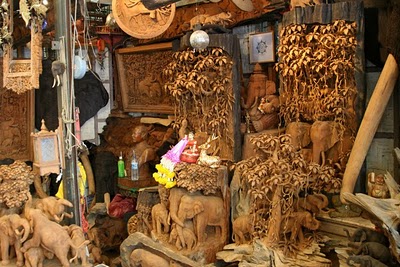
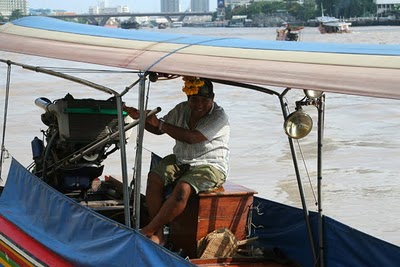
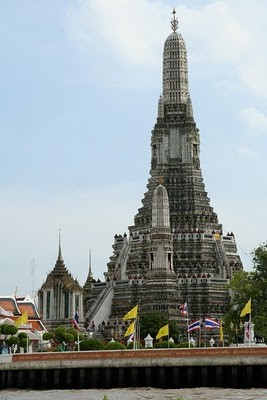
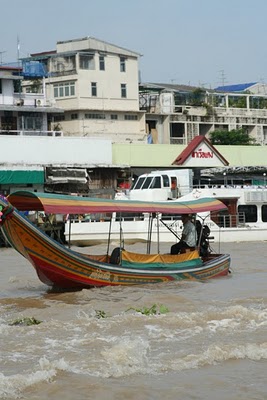
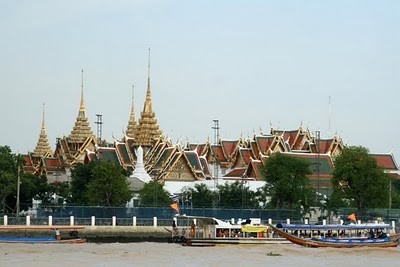
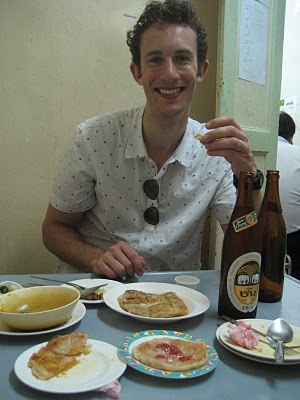
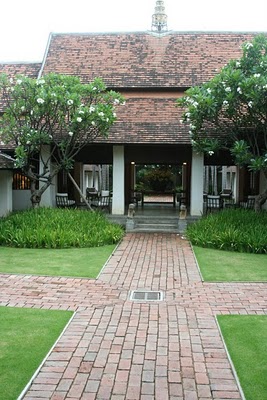
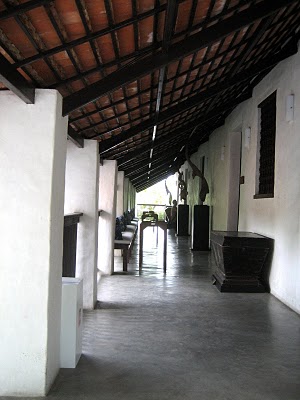
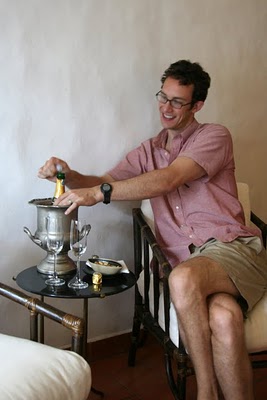
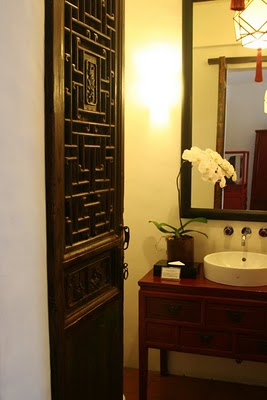
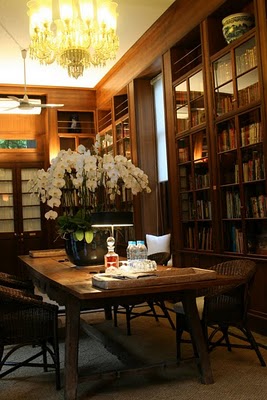
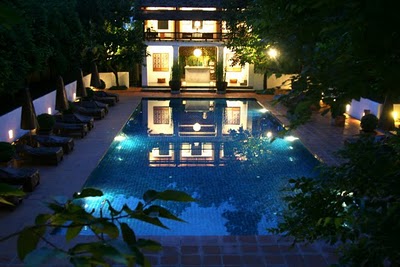
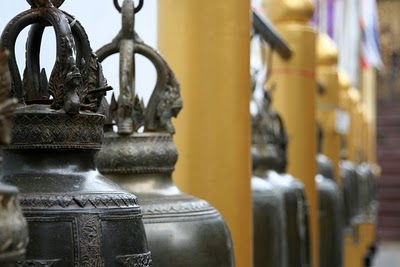
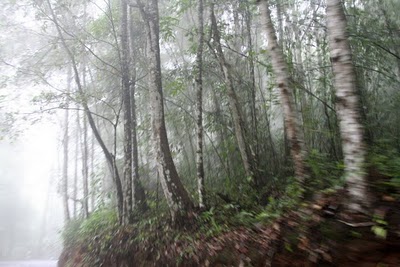
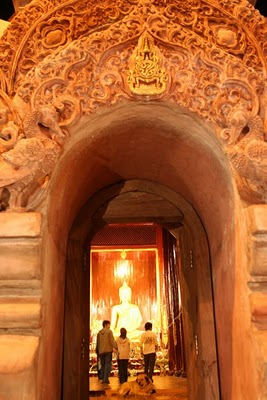
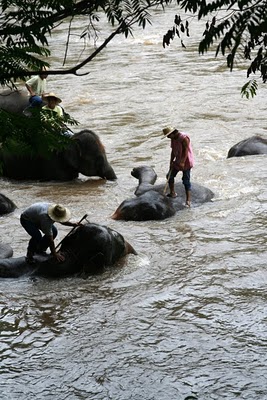
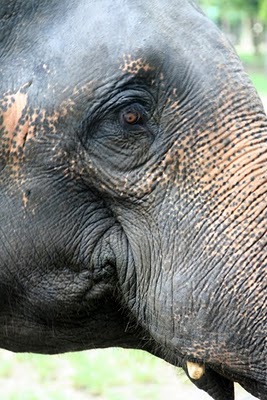
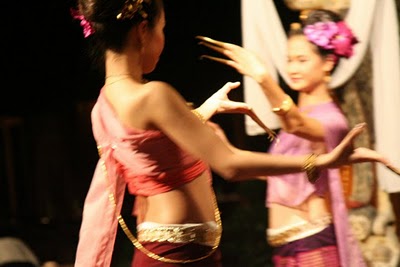
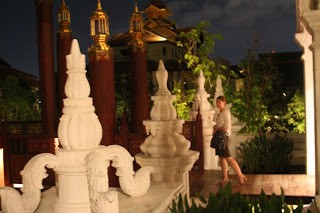



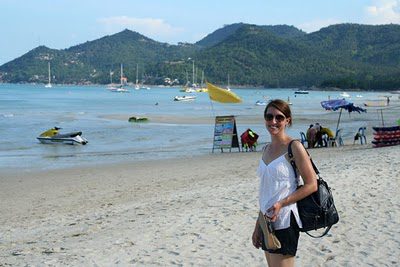
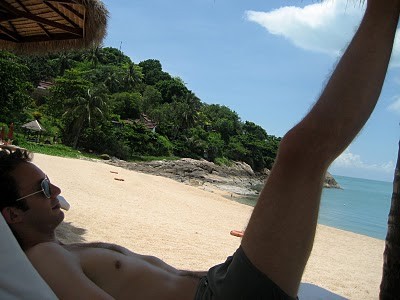
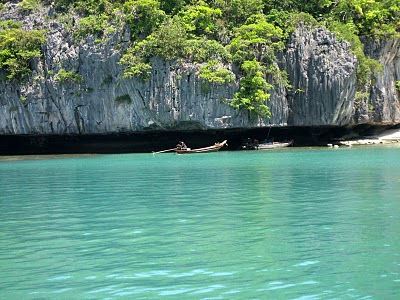

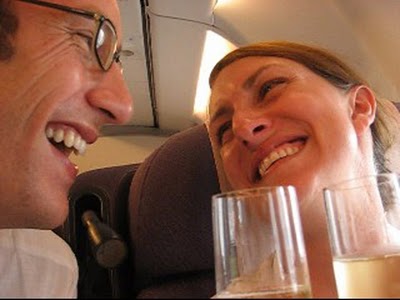

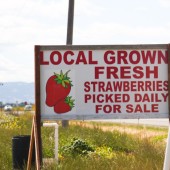
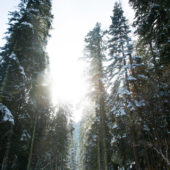
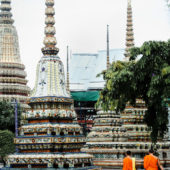









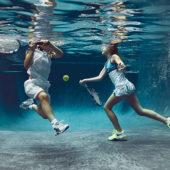
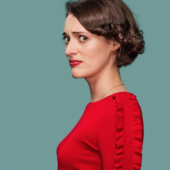
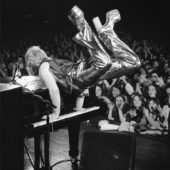
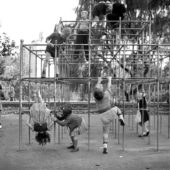


















15 Comments